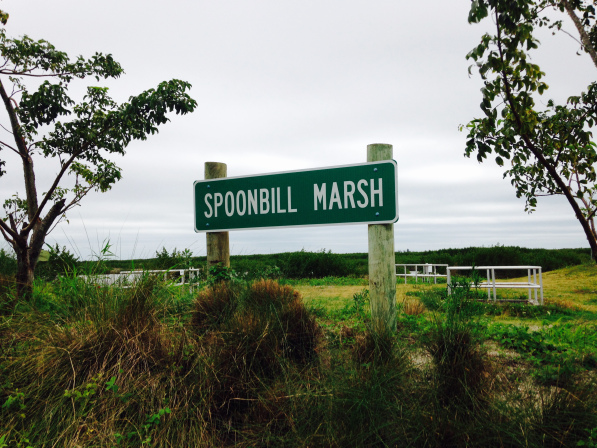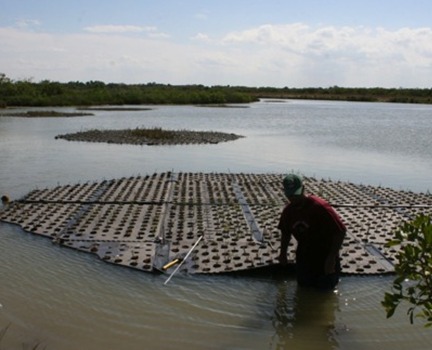
ON JULY 8, 2015 WE WROTE AN ARTICLE ENTITLED “SPOONBILL MARSH, AN ENVIRONMENTAL MARVEL.”
IN IT WE WROTE THAT WHEN THE US ENVIRONMENTAL AGENCY ORDERED THE FLORIDA DEPARTMENT OF ENVIRONMENTAL PROTECTION TO STOP INDIAN RIVER COUNTY (IRC) FROM PIPING “DEMINERALIZATION CONCENTRATE” (AKA BRINE) FROM THEIR WATER TREATMENT PLANTS DIRECTLY INTO THE INDIAN RIVER LAGOON, THE IRC COMMISSIONERS CHOSE AN ENVIRONMENTAL SOLUTION BY CREATING SPOONBILL MARSH, APPROXIMATELY 63 ARCES LARGE, OWNED BY GRAND HARBOR, LOCATED ON THE WESTERN SHORE OF THE LAGOON, NORTH OF GRAND HARBOR.
We wrote that the principle scientist and developer of the Marsh, C. E. (Chip) Swindell, Jr., president of Ecotech Consultants, located here in Vero Beach said that: “For over 35 years I’ve done water-related projects in Australia and Guatamala (wetlands/wildlife services/wetland treatment systems) and Spoonbill is the best thing I’ve ever done.”
The way the Marsh works is that water from the Lagoon is pumped into it and goes through “cells” where phosphorous and nitrogen are absorbed by limestone, mangroves and other vegetation; oysters filter out pollution, solids settle and then the Lagoon water flows on into the marsh where it mixes with the brine from the IRC water treatment plants. The combined water is cleaned by the Marsh and pumped back out into the Lagoon.

According to the Mr. Swindell, the salinity ranking of pure water is zero. However, the salinity ranking of water entering the Marsh as brine is 2.5 whereas the water entering the Marsh from the Lagoon is 25.
An analysis conducted and overseen by Vincent Burke, Indian River County Utilities Director, for the Year January 2012 – December 2013 with respect to cleanliness of the water related to Spoonbill Marsh is as follows:
Brine entering the Marsh from Reverse Osmosis Plant Discharge: 4,988 lbs. Nitrogen 327 lbs. Phosphorus
Water entering the Marsh from the Indian River Lagoon: 8,278 lbs. Nitrogen 2,165 lbs. Phosphorus
Total of nitrogen and phosphorus entering the Marsh: 13,267 lbs. Nitrogen 2,493 lbs. Phosphorus
Water entering the Indian River Lagoon from Spoonbill Marsh: 4,408 lbs. Nitrogen 496 lbs. Phosphorus
The net effect is that during 2013 the nutrient load removed from the Lagoon by Spoonbill Marsh was 8,768 lbs. of Nitrogen and 1,996 lbs. of Phosphorus.
After hearing that then Vero Beach City Counselor Mr. Jay Kramer was overheard in City Hall saying that the Marsh does NOT work, but was unable to provide any documentation that it does not work other than sending an email that I could access the data on a Florida Department of Environmental Affairs “Oculus” website, we went to the Oculus website and found I would need a MIT degree to navigate it. Here are some excerpts from the site:
Welcome to the Florida DEP Consolidated OCULUS Electronic Document Management System.
Help using OCULUS
We have several tools available to assist in using the OCULUS Document Management System. At any point, users can click the help menu to open the Online help system. For help finding documents in OCULUS, please see the Public Document Taxonomy. If you believe that you’ve found an error with a document, please contact servicedesk@dep.state.fl.us to report the problem.
At times Microsoft Office updates may cause users to lose the ability to “View” TIF documents in OCULUS and limit their options to ‘Save’ or ‘Cancel’ when trying to view them. If your computer is experiencing this problem, please try the steps outlined in this document.
If you can open documents correctly but find black pages while viewing ‘TIF’ documents from OCULUS or you are having other trouble viewing documents, please follow these instructions for help installing an alternative viewer.
If you find that you cannot view or open a document type of ‘.MSG’, ‘.PST’, or ‘.OST’, email formats, you may not have compatible software for these file types.
Please visit .MSG viewer download page to download the free Mail Viewer or visit .PST or .OST viewer download page to download the free Outlook Viewer for viewing these file formats outside of MS Outlook.
Out of frustration, we then contacted the Florida DEP for help in determining if Spoonbill Marsh was or was not working. Thanks to the efforts of Ms. Erma Slager, who was very generous with her time and others at FDEP to obtain the requested FDEP documentation, this is the report she provided.
“Hello Mr. Hardy-
Spoonbill Marsh treats both demineralized reverse osmosis brine concentrate from the Indian River County Utilities treatment facility and the Indian River Lagoon which are mixed at the head-works of Spoonbill Marsh. The combined water then flows through the cells of the Spoonbill Marsh where nutrient uptake is accounted for by the natural flora and fauna in the marsh before the treated waters are discharged back to the Indian River Lagoon.
As required in its permit, Indian River County Utilities has provided detailed Total Nitrogen (TN) and Total Phosphorus (TP) removal information/data to the department on a weekly, monthly and annual basis for the years 2010,2012,2013,2014. The department has used this data to estimate the annual TN and TP intake loads. To calculate the TN and TP reductions, department staff identified the difference between intake loads (from brine concentrate and Indian River Lagoon intake) and the outlet loads back to into the Indian River Lagoon. Based on four years of data, the calculations indicate that the removal for Spoonbill Marsh is approximately 10,500 lbs of TN and 2,700 lbs of TP.
Thank you for your patience and if there’s anything else I can do for you, please don’t hesitate to contact me.
Have a great afternoon,
Erma Slager
Florida Department of Environment Protection
Office of Communications
Press Office”
Based on this data we wrote an article on July 16, 2015 that “Spoonbill Marsh Does Work.”
Now what is happening is a local group in Indian River County, apparently led by Mr. Barry Shapiro is challenging the proper functioning of Spoonbill Marsh; that it is not being properly maintained by the county with specific regard as to how it collects and reports data.

Barry Shapiro / LinkedIn
On August 20, 2016 Mr. Shapiro sent this email to 64 public officials, environmentalists and media contacts.
“I have been led to believe this is not only an environmental tragedy but also a potentially criminal action. I have since spoken with a number of experts who have either confirmed the report or agreed with and in some cases added to the available anecdotal information.To say the least, I am angry and I want action.
The report shows that the Spoonbill Marsh Wastewater Treatment facility was not built to its approved design, is not being operated by Indian River County within the restrictions of its operating permit, including knowingly allowing illegal discharges of untreated wastewater, and that county officials have submitted false and misleading information about the facility’s operation to cover up this this illegal activity from regulators and
the public.
In addition to the report I am submitting, Spoonbill is having a negative impact on fish breeding and surrounding native flora. Spoonbill is not functioning as a native wetland and is not functioning as it was designed to do. Despite the protestations of many scientific and environmental experts the county officials went to great expense to create the three marshes that treat waste water in the county.”
We responded to this email with the data provided above and Mr. Shapiro responded that: “It appears IRC underreports.”
Also, on August 26, Mr. Shapiro issued this news release:
“FOR IMMEDIATE RELEASE
LOCAL CANDIDATES DEMAND AN AUDIT OF SPOONBILL MARSH
REPORTED DISCREPANCIES AT COUNTY FACILITY BRING CONTESTED WATER TREAMENT SYSTEM BACK INTO POLITICAL ARENA
Recently revealed discrepancies in reporting of wastewater levels at Spoonbill Marsh have thrown the Indian River County water treatment site into the spotlight and several candidates for the County Commission are demanding an independent audit. Vero Beach Mayor Jay Kramer, retired firefighter Joe Earman, former Sebastian Mayor Richard Gillmore and County Sheriff’s Department Officer Chuck Kirby have all seen the report and signed on to a joint statement demanding an independent audit of the facility.
District 1 candidate Susan Adams has indicated she supports an investigation but wanted a chance to talk with county staff before making a final decision.
The report claims that Spoonbill Marsh is not operating within its permit guidelines, is overflowing its banks, is flooding the adjoining properties and is not properly monitored. One adjoining property is an environmentally significant salt marsh under construction and owned by the Indian River Land Trust
According to ecological expert Dr. Grant Gilmore, Spoonbill is also killing off fish species and altering migration patterns.
Contact: Barry Shapiro
917-225-1231lighthousegalleryandevents@gmail.com
Vero Beach, FL 32966
When reached for comment, the principle designer and developer of the Marsh replied:
“This guy is so out of touch with reality that a response to his rambling accusations is not warranted at this time.”
When I asked Mr. Shapiro for documentation of his findings he referred me to this PDF file of the report. When asked who authored it he wrote: “Thomas, as I have repeatedly said, I will not divulge the source of the material but you can talk to experts like Dr Grant Gilmore or David Cox as to the authenticity of the information…I’m confident of my source.”
So let’s see how this plays out.

Spoonbill Marsh watercolor by Sue Zimmerman
Pingback: Our Correspondence with the Florida Environmental Protection Agency About Spoonbill Marsh. | Vero Communiqué
Pingback: Hard Data is in Conflict With the Unsubstantiated Allegation that Indian River County, FL’s Spoonbill Marsh is “Not Only an Environmental Tragedy But Also a Potentially Criminal Action.” | Vero Communiqué